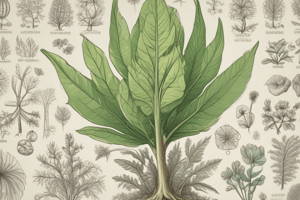Podcast
Questions and Answers
What is the primary function of the cuticle in plant structures?
What is the primary function of the cuticle in plant structures?
- To prevent water loss (correct)
- To provide structural support
- To regulate temperature
- To facilitate gas exchange
What is the haploid generation in the life cycle of plants responsible for producing?
What is the haploid generation in the life cycle of plants responsible for producing?
- Flowers
- Seeds
- Spores
- Gametes (correct)
What is the primary function of grana in chloroplasts?
What is the primary function of grana in chloroplasts?
- Storage of nutrients
- Regulation of gas exchange
- Sites of photosynthesis (correct)
- Synthesis of organic molecules
What is the main function of roots in plants that adapted to life on land?
What is the main function of roots in plants that adapted to life on land?
In what order did the major structures appear in the evolution of plants?
In what order did the major structures appear in the evolution of plants?
What is the function of the vascular tissue xylem in plants?
What is the function of the vascular tissue xylem in plants?
In which group of plants does the gametophyte generation dominate?
In which group of plants does the gametophyte generation dominate?
What is an advantage of bilateral symmetry in animals?
What is an advantage of bilateral symmetry in animals?
What is a characteristic unique to animals?
What is a characteristic unique to animals?
What adaptation was necessary for animals to transition from water to land?
What adaptation was necessary for animals to transition from water to land?
What is a difference between protostomes and deuterostomes?
What is a difference between protostomes and deuterostomes?
What is an advantage of sexual reproduction?
What is an advantage of sexual reproduction?
Flashcards are hidden until you start studying
Study Notes
Plant Structures and Functions
- Chloroplasts contain chlorophyll and are responsible for photosynthesis
- Cell walls are made of cellulose and provide structural support
- Specialized reproductive organs include flowers and cones
- Vascular tissues (xylem and phloem) facilitate water and nutrient transport
Alternation of Generations in Plants
- Involves a cycle between a haploid gametophyte generation (producing gametes) and a diploid sporophyte generation (producing spores)
- Allows for both sexual and asexual reproduction
Transition from Water to Land in Plants
- Major adaptations include:
- Development of a cuticle to prevent water loss
- Roots for anchorage and absorption of water and nutrients
- Vascular tissues for internal transport
Leaf and Plant Structures
- Cuticle: reduces water loss
- Stomata: regulate gas exchange
- Chloroplasts: contain chlorophyll for photosynthesis
- Cell walls: provide structural support
- Grana: sites of photosynthesis
- Stroma: involved in the synthesis of organic molecules
Evolution of Plant Structures
- Order of appearance: cuticle, stomata, roots, seeds, and finally flowers
Sporophyte and Gametophyte Generations
- In bryophytes, the gametophyte is dominant
- In ferns and gymnosperms, the sporophyte is dominant
- In angiosperms, the gametophyte generation is greatly reduced
Characteristics Unique to Animals
- Multicellularity
- Heterotrophy
- Locomotion
- Nervous system
- Sexual reproduction
Cladogram and Phyla
- A cladogram can be used to recognize which phyla possess a given characteristic
Transition from Water to Land in Animals
- Key adaptations include:
- Development of limbs for movement
- Lungs for respiration
- Skin adaptations to prevent desiccation
Symmetry in Animals
- Bilateral symmetry offers better mobility, efficient hunting, and directional movement compared to spiral symmetry
- Bilateral symmetry is associated with triploblastic animals (three germ layers: ectoderm, endoderm, and mesoderm)
- Radial symmetry is associated with diploblastic animals (two germ layers: ectoderm and endoderm)
Protostomes and Deuterostomes
- Protostomes: blastopore develops into the mouth, and the anus forms later (e.g., mollusks, annelids, and arthropods)
- Deuterostomes: blastopore develops into the anus, and the mouth forms later (e.g., echinoderms and chordates, including vertebrates)
Asexual Reproduction
- Animals: budding (e.g., Hydra), fragmentation (e.g., starfish), and parthenogenesis (e.g., some lizards)
- Plants: vegetative propagation (e.g., runners in strawberries), fragmentation (e.g., spider plants), and budding (e.g., yeast)
Sexual Reproduction
- Advantages: genetic diversity, elimination of deleterious mutations through recombination
- Disadvantages: energy and time required to find a mate and produce offspring, risk of producing unfit offspring, and potential for genetic variability
Studying That Suits You
Use AI to generate personalized quizzes and flashcards to suit your learning preferences.




